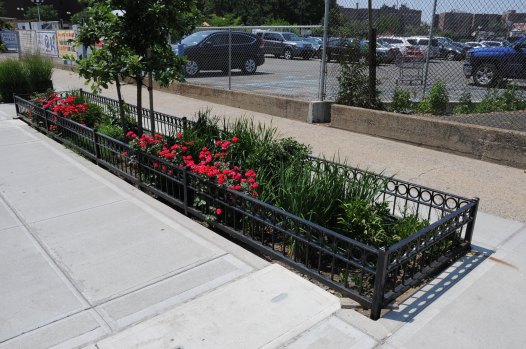
A combination of New York’s new subtropical climate and the fact that most subway stations are underground means that the flash flood scenes like those seen in the summer of 2021 aren’t ever going to completely go away. But as we enter a bold new era of ruinstorms, experts say the city and the MTA can at least work on mitigating the worst of the floods by going green. Literally.
“In a lot of ways the MTA and its infrastructure is the last line of defense,” said TransitCenter Communications Director Ben Fried. “When you get to the city level this is a problem that affects more than just the subway, and mitigation is going to involve a lot more than subway infrastructure. So it’s really incumbent on the city to get creative and ambitious about creating more permeable surfaces on the streets, this enormous, impermeable, right of way that it controls.”
When the remnants of Hurricane Ida settled over New York and dumped three inches of rain on parts of the city in just an hour, it did more than shatter the hourly rainfall record set on the day of the city’s ill-fated homecoming concert in Central Park. It also led to scenes of water gushing out of subway walls and running over tracks like log flumes, and stranded 1,000 subway riders across the city. Since on a normal day the MTA pumps 14 million gallons of water that seeps into the subway system every day, it’s incumbent on the city to create streets and sidewalks that can actually absorb water.
“I’m not saying that we can prevent three inches of rainfall in an hour from causing any damage or harm, but we can prevent it from causing so much damage and so much harm. I think it’s technically possible possibility, but we just have to make it a political reality,” said Fried.
The subway can only handle rainfall of 1.75 inches per hour — an amount that used to be considered extremely rare, but isn’t anymore.
WaPo has a MUCH clearer analysis than the multi-reporter NYT piece. Rip up the damn pavement! https://t.co/WY45NzvUEB
— Radlerkönigin (@radlerkoenigin) September 3, 2021
Underscoring the importance of city and MTA cooperation, Negret’s July missive mapped the DEP’s own moderate and extreme scenario flood maps on the subway map to see which stations were vulnerable to flooding during heavy rain. The extreme flood map, which looked at rates of 3.5 inches of rain per hour, showed that the 28th Street 1 stop, where water gushed out of a platform wall during Wednesday’s floods, was one of almost 400 stations that could be impacted by continuous or nuisance flooding.
There are hints of an era of cooperation around flash flood mitigations though. Interim MTA Chairman and CEO Janno Lieber said one of his first actions when he sat in the big chair was to call the DEP and the transit agency.
“When I came in a couple of weeks ago, one of the first things I did was to establish an urgent collaboration with the city of New York’s Department of Environmental Protection, which runs the sewer system and the drainage system, about how are we going to start to deal with this flash flooding problem, this problem that is emerging in the era of climate change,” Lieber said at a press conference on Long Island on Thursday. “Today was a day we actually had scheduled a series of outings to do that.”
And climate experts warn that we shouldn’t be mollified when Ida’s wrath is described as a “500-year storm.” A 500-year storm means that each year there’s a 2 percent chance seeing the kind of extreme storm that hit on Wednesday, according to Columbia University’s Mona Hemmati.
“This percentage may increase in the future due to climate change as some studies have shown and we may have multiple events like what happened last night within just one year,” said Hemmati, a post-doctoral student at the Lamont-Doherty Earth Observatory, Earth Institute. “It’s uncertain how often we are going to see such an event, but we expect to see these extremes more often. The bottom line is that climate change makes these extreme events more probable and intense as warmer atmosphere holds more moisture like a big sponge, and these numbers should be updated considering climate change.”
Here are two videos from Streetfilms about how this is working elsewhere:





